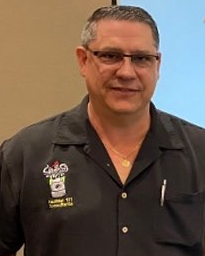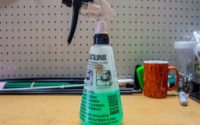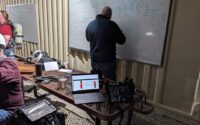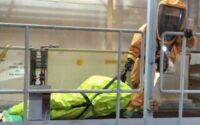Carbohydrillium Gas Cylinder Failure – First Due Report
Bob Coschignano & Ed Maerkl

On September 26th, 2013, at approximately 1230 hrs. the City of Orlando Fire Department was dispatched to multiple reports of an explosion in the downtown corridor.
Units arrived to find a huge hole (approx. 50’ wide) in the brick wall in the rear of the building in question. The building was an approximately 38,000 square foot, warehouse type structure with a combination of construction styles, including steel I-beam, Terracotta block and wood floor and sub-structure.
The first due District Chief arrived, established command, and implemented a NIMS command structure. Command allocated units by task. Special Operation units: Engine 101, Hazmat 1 and Tower 7 were assigned by command to collaborate and form the hazardous materials group. Heavy Rescue 1 evaluated the structure for stability and established proactive RIT. Tower Company 1 was tasked with controlling utilities and Engine Company 1 established a supply line and protection lines in the event of fire or secondary explosions.

Rescue 1 became the Ready Rescue in the event of victims being found or fire fighter injury. The second arriving District Chief became the Safety Officer. Several other units responded initially but primarily assisted in establishing a safe zone and denying entry to civilians which eventually was taken over by PD. The nearby railroad also had to be shut down due to units being staged too close and supply lines crossing tracks. Railroad supervisors were integrated into a unified command structure, as was a PIO due to the mounting media interest, in addition to various federal offices, which were nearby. The departments Arson/Bomb Squad began the task of interviewing eyewitnesses as well as the building owner and staff.
Early on, a clear path of destruction was prominent on the ground floor Bravo/Charlie quadrant, which provided a suspected area of origin. The basement was searched for victims, damage to below grade structural components (floor joists etc.) and hazardous atmospheres, of which none were found. On the ground floor there was heavy destruction, however no fire damage was present as one would expect with a natural gas leak finding an ignition source. Scattered throughout the debris outside and in the room of origin, were various large pieces of equipment and several red colored 150 lb. type gas cylinders.
Arson /bomb division reported, after speaking with the building owner, that he was working with an experimental gas he called carbohydrillium, used for cooking and industrial purposes. Units withdrew from the building at this time and the hazardous materials officer (E101 officer) met with the building owner and his “scientist”. They reported that there was not a proper safety data sheet (SDS), nor was the exact chemical formula for this mixed gas known. They did provide some approximate values of gases contained in this product as well as describing the general procedure for making it.

This interview yielded that there was, oxygen, carbon monoxide, carbon dioxide, nitrogen and hydrogen in undetermined levels in the mixture (Other compounds present include acetylene, methane, ethylene, ethane, propane, propylene, and other light chain carbon compounds) and the owner reported that he had some previous “minor” tank failures in months past. After this information was provided, further investigation was conducted in the area of origin and what had initially appeared to look like a flat piece of pitted steel was actually the remains of the failed tank that had completely unraveled flat the top valve assembly was hidden by debris, so it was not easily recognized.
A meeting with command, the bomb squad, and the hazmat team ensued, to establish an action plan. It was determined that the safety of the existing cylinders posed a potential hazard that needed to be mitigated, to prevent future issues and for public safety. There was great discussion on the best practice for dealing with the remaining tanks, which numbered about ten. The owner had provided a sketch of where the full and empty tanks were originally located, this ended up being of little help as the explosion had moved nearly all of them. The owner did not otherwise document them as full or empty. Ideally, the use of the EOD robot was the first choice as it was an unmanned operation; however, the Bomb Squad did not feel the robot could have effectively maneuvered the debris in this situation.

The second option was a Bomb Technician in blast suit. This again was debated, however due to the lack of vision and mobility in the suit moving over and around the debris could have been more of a hindrance and hazard than a solution. The final decision came down to the Hazardous Materials Team. It was decided that a two-person team utilizing bunker gear with SCBA, air monitoring detection and an unmanned Rapid Attack Monitor (RAM) nozzle to hydraulically ventilate the gases out through the breach in the wall and to provide some protection in the event of a failure or fire to the operating crew. A Rapid Intervention Team and Ready Rescue would also be on standby.
The first step was in setting up the unmanned monitor, and moving the bomb robot into a position to monitor sound and video for the room so the entry team and cylinders could be observed. A two-person entry team entered the structure and proceeded to the first cylinder. It had been decided to mark each bottle with a number, crew name, date and time in a conspicuous place to keep track of how many bottles we rendered safe. The first bottle was encountered, uncapped and valve cracked to begin venting process. Entry team withdrew, activated the hydraulic RAM nozzle and made way to a pre identified area of safe refuge. A four-gas monitor with PID was within ear and eye shot of the robot camera to document readings of the actual gas. Alarm levels on both carbon monoxide and lower explosive level noted (with no fog line LEL 72%, CO 35 ppm, under fog line LEL 1-5%, CO 2ppm). Once complete, the RAM was secured and moved to the next bottle. This process was repeated for all 10 cylinders with multiple entries being made by the hazardous materials team. A map of the location of all the bottles handled was made and passed along so that each team could start where the other left off. All the bottles were safely bled off without incident. The time of incident was approximately seven hours operating on scene.
There were several lessons learned from this incident:
- Safety is number one, both for personnel and the public.
- A strong inter-agency unified command is imperative and contributed to the overall success of the incident.
- Gaining intelligence from a variety of sources to include owner/occupant if possible.
- It is important to conduct a risk versus gain analysis and establish an Incident Action Plan (IAP).
- Rotate crews to prevent fatigue and provide adequate rehab.
- Resist the pressure to open highways, railways or other traffic avenues until incident allows.
This particular variety of experimental cooking gas is gaining popularity in locations all over the United States and appears to be held to little regulation.




